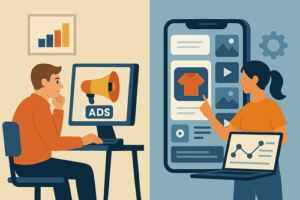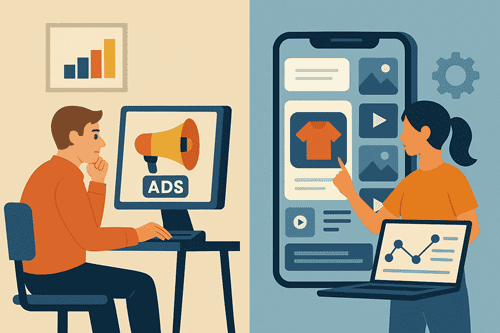Is your advertising strategy still stuck in 2022? If performance has plateaued, and you’re spending more to get less, it might not be your product or offer that’s the problem. It could be your approach. The landscape has shifted dramatically, and the gap between those embracing change and those resisting it is only widening. Here are five clear signs your ad campaigns haven’t caught up with where digital marketing is heading in 2025.

1. You’re Not Leveraging AI-Driven Ads
This is the clearest red flag. If you’re still building every campaign manually, fine-tuning targeting, and A/B testing creatives the old-school way, you’re operating at a huge disadvantage.
AI ads have gone from experimental to essential. And nowhere is this more evident than on Meta’s platforms. With its latest tech, Advantage+ and the Andromeda retrieval engine, Meta is reshaping how campaigns are launched, scaled, and optimised. These tools aren’t gimmicks. They’re producing tangible results.
Advantage+ can instantly test dozens of creative variations, optimise spend in real time, and find winning combinations without you lifting a finger. It’s especially powerful for ecommerce brands who want to scale without a full media team. Advertisers using it have seen significant lifts in ROAS and drops in CPA. The Andromeda engine, meanwhile, selects the most relevant ad for each user in milliseconds. This precision reduces waste and boosts ad recall.
Still not using them? You’re giving your competitors a massive head start.
2. You’re Spending Too Much Time on Manual Optimisation
If your team is constantly in the weeds—adjusting bids, tweaking placements, creating static lookalike audiences—you’re wasting time. Time that could be spent on strategy, creative direction, and deeper customer insights.
Modern ad tools are built to free up this labour. With dynamic audience targeting and automated creative testing, you don’t need to micromanage every ad set. Platforms like Meta, Google, and TikTok now provide systems that self-optimise based on live data signals. That means better performance, and more bandwidth for your team to focus on the big picture.
Hanging onto manual optimisation as a default is like choosing to handwash clothes when you’ve got a fully functioning washing machine. There’s a time and place for hands-on work, but not every day.
3. Your Targeting Strategy Hasn’t Evolved
Are you still relying on basic demographics, interests, or old lookalike audiences? That’s a red flag.
Online behaviour has shifted. Users jump between platforms, content types, and purchase journeys quickly. Relying on static segments isn’t enough anymore. Platforms now use real-time signals to adjust who sees your ads, meaning your ideal audience could change from one week to the next.
Smart advertisers are integrating customer data, building flexible audience structures, and letting performance guide who sees what. If your targeting has been set and forgotten, you’re missing opportunities to reach people who are actively showing buying signals.
In 2025, adaptability wins. If your targeting is still locked into last year’s assumptions, it’s likely dragging your results down.
4. You Don’t Have Enough Creative Variations
One headline, one image, one video — and you expect that to work across every channel and audience? That’s wishful thinking. Creative ad fatigue happens faster than most people realise. Even great ads burn out after a while, and if you’re only producing a handful of variations per campaign, chances are your audience is tuning out.
Modern campaigns require a steady stream of fresh content. But that doesn’t mean you need to triple your production costs. Tools now exist to help generate different copy and visuals more efficiently, and many advertisers are building systems that remix core assets into multiple variations quickly.
The brands seeing the best performance are producing a lot of creative content, testing it rapidly, and moving on from what doesn’t work. If your ads are visually stale or creatively limited, your campaign results will reflect that.
5. You’re Relying Too Heavily on One Platform
Still putting your entire ad budget into one channel? That might’ve worked before, but it’s risky now. Different platforms serve different roles in the buyer journey: some are discovery-heavy, others are intent-driven, and some lean more towards brand engagement or community building.
If all your spend is locked into just one environment, you’re probably missing out on other high-value touchpoints. You’re also more exposed to platform changes, whether it’s rising costs, algorithm updates, or bugs that tank performance unexpectedly.
Diversification is smart. It helps you learn faster, reach broader audiences, and avoid having all your eggs in one basket. Brands that are winning right now are balancing discovery platforms with high-intent channels and experimenting across the board.
If you haven’t reallocated your budget in over a year, chances are it no longer reflects where your customers are spending time.
So, What Now?
If two or more of these signs hit close to home, you’re not alone, but it’s also time to act. Campaigns today look very different than they did even 18 months ago. Automation isn’t a nice-to-have anymore. Cross-platform strategy isn’t optional. Creative production needs to scale. And campaign management isn’t about adjusting settings all day; it’s about guiding strategy, understanding data, and building systems that can evolve.








